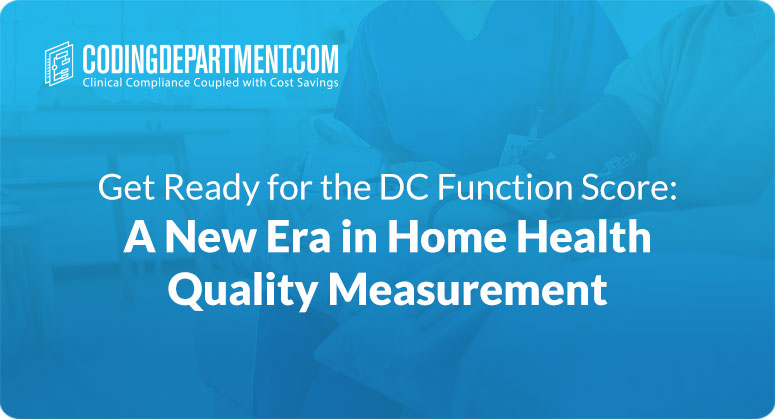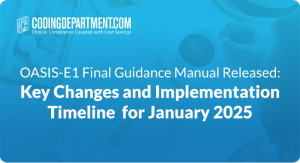The home health landscape is evolving, and with it comes a new set of quality measures. Mark your calendars: the Discharge Function Score (DC Function) is now officially part of Care Compare, impacting Home Health Value-Based Purchasing (HHVBP) and requiring clinicians to sharpen their OASIS assessment skills, particularly around GG functional items. This blog post will equip you with the knowledge you need to excel in this new era of quality measurement.
The DC Function Score: What You Need to Know
As of January 15, 2025, the DC Function quality measure is publicly reported on Care Compare. Based on data from April 1, 2023, to March 31, 2024, this score reflects a patient’s improvement on select self-care and mobility measures, weighed against CMS’s expected improvement. Critically, these results will influence HHVBP scores beginning with the 2025 performance year, meaning potential payment adjustments for agencies in 2027.
The DC Function Score uses select OASIS GG item responses, which offer greater specificity than previous measures. Understanding CMS’s expectations for these scores, while acknowledging real-world limitations, is crucial for developing effective care and discharge strategies.
Navigating the Challenges
Implementing the DC Function score presents some challenges. Resource allocation for training and quality review, as well as the potential confusion between legacy M items and GG items, are key concerns. Leveraging automated scrubbers to streamline data collection and analysis and developing standardized assessment procedures, including shadowing opportunities, can also ensure continuous improvement in GG item scoring.
Tips for Success with the DC Function Measure
- Beef Up Education: Comprehensive initial and ongoing OASIS education, including realistic scenarios and examples, is vital. Clinicians must understand the guidance for all functional items, particularly the GG items used in the DC Function score, and the importance of accurate scoring. Crucially, avoid using the “activity not attempted” codes for DC Function score items, as CMS will estimate the score based on statistical imputation.
- Get Out in the Field: Onsite visits with staff to observe patient performance of functional tasks are essential. “The OASIS assessment is not an interview,” McClammy stresses. Clinicians must observe and document the patient’s actual performance, even if the patient is resistant or doesn’t typically perform the task.
- Focus on Accuracy: Accurate assessment and scoring are paramount. Emphasize the importance of observing the patient’s actual abilities rather than relying solely on patient reports.
- Education: It’s crucial to provide thorough and continuous OASIS education, using real-life scenarios and examples. Clinicians need to grasp the guidelines for all functional items, especially the GG items used in the DC Function score, and understand why accurate scoring is so important. It’s critical to avoid “activity not attempted” codes for DC Function score items, as CMS will then estimate the score using statistical imputation.
- Field Visits: Conducting onsite visits with staff to observe patients performing functional tasks is essential. The OASIS assessment relies on observation, not interviews, so clinicians must document the patient’s actual performance, even if the patient is reluctant or doesn’t usually do the task.
- Accuracy: Accurate assessment and scoring are vital. Clinicians should prioritize observing the patient’s actual abilities instead of depending solely on what the patient reports.
DC Function Measures: The GG Items
The following GG items are included in the DC Function measure:
- GG0130 (Self-Care):
- GG0130A (Eating)
- GG0130B (Oral hygiene)
- GG0130C (Toileting hygiene)
- GG0170 (Mobility):
- GG0170A (Roll left and right)
- GG0170C (Lying to sitting on side of bed)
- GG0170D (Sit to stand)
- GG0170E (Bed-to-chair transfer)
- GG0170F (Toilet transfer)
- GG0170I (Walk 10 feet)
- GG0170J (Walk 50 feet with two turns)
- GG0170R (Wheel 50 feet with two turns – used in place of walking activities for patients who don’t walk at both SOC/ROC and discharge)
Home health agencies can ensure accurate data collection, improve patient outcomes, and succeed in value-based care by prioritizing education, implementing strong quality assurance processes, and understanding the nuances of GG item scoring.
The final 2023 report, containing the finalized percentage impacting 2025 payments, has been publicly released. In 2025, all claims with a date of service in that year will be subject to the updated Value-Based Purchasing calculations, with the 2023 performance percentage applied as an increase or decrease.
At CodingDepartment.com, we are always ready to assist you overcome these challenges: Free Trail Page – Expert Home Health Coders
To view CMS’ overview document of the new measure, click: Technical Report Discharge Function Score for Home Health (HH) | CMS






